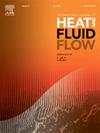Experimental and numerical study on heat transfer and energy storage characteristics in double-layered enclosure packed with microencapsulated phase change material
IF 2.6
3区 工程技术
Q2 ENGINEERING, MECHANICAL
International Journal of Heat and Fluid Flow
Pub Date : 2025-01-23
DOI:10.1016/j.ijheatfluidflow.2025.109757
引用次数: 0
Abstract
Heat transfer and energy storage characteristics in double-layered enclosure packed with microencapsulated phase change material (MEPCM) are investigated numerically and experimentally in details. The rectangular enclosure is partitioned by an Al-plate to provide a double-layered enclosure. The top surface of enclosure is heated with varied heat flux with sine wave variation, the bottom surface is maintained at a low and constant temperature and the other vertical surfaces are thermally insulated. Two microencapsulated phase change materials made by paraffin with melting temperatures about 28 ℃ and 37℃, are selected. The high-temperature wall heat fluxes () of , and are considered. The low-temperature wall boundary conditions are set to ℃, ℃ , and ℃ The results show that better net thermal energy storage is found for a case with a higher wall heat flux at the top surface. In addition, better thermal energy storage is noted when the MEPCM with low melting temperature is packed at the upper enclosure near the heated wall. Also, more energy storage is experienced for a double-layered enclosure with a higher partitioned ratio λ. The melting point temperature of microcapsule phase change materials needs to be between high/low-temperature wall heating conditions to effectively store heat.
求助全文
约1分钟内获得全文
求助全文
来源期刊

International Journal of Heat and Fluid Flow
工程技术-工程:机械
CiteScore
5.00
自引率
7.70%
发文量
131
审稿时长
33 days
期刊介绍:
The International Journal of Heat and Fluid Flow welcomes high-quality original contributions on experimental, computational, and physical aspects of convective heat transfer and fluid dynamics relevant to engineering or the environment, including multiphase and microscale flows.
Papers reporting the application of these disciplines to design and development, with emphasis on new technological fields, are also welcomed. Some of these new fields include microscale electronic and mechanical systems; medical and biological systems; and thermal and flow control in both the internal and external environment.
 求助内容:
求助内容: 应助结果提醒方式:
应助结果提醒方式:


